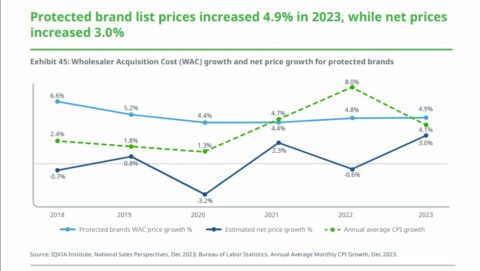My default assumption about most of the PBM reform proposals that have been circulating on Capitol Hill is that they’re smallball: they snack around the edge of the PBM business model but offer little that will change the fundamentals of the drug supply chain in ways that patients will notice.
But a new Senate Finance Committee proposal released yesterday, in advance of a vote next week, is forcing me to reconsider my nonchalance. The legislation language would do a couple of interesting things worth talking about. (I’m relying on the media coverage here. It’s been a long week, and I haven’t dug into the text. If any of you have a smart take on this — or want to set me straight — I’d love to hear it.)
First, as detailed most clearly in this STAT story, it would create a provision by which Medicare patients would see their coinsurance based on the net price for medicine rather than list prices. It sounds like the boundaries of that policy might be narrow: it just applies to Medicare, and only highly-rebated meds are impacted, but that feels like a concrete step in the right direction.
Second, as Endpoints flags, the new effort would compel plans to favor Part D biosimilars in formulary coverage. This is an area of enormous market failure right now — AbbVie’s ability to maintain nearly all the Humira market despite a passel of biosimilars is Exhibit A — and the proposal seems to understand that simply putting biosimilars and brand-name products on the same formulary tier just doesn’t get the job done.
So I’m suddenly back engaged in this particular process.
I really want to like the ICER “fair access” report that dropped today. It is, theoretically, an incredibly important endeavor, using objective measures to see if insurance plans are making patient-access decisions based on value-driven metrics rather than profit-driven ones.
The word “theoretically” is doing a lot of work in the paragraph above.
Because, in practice, the ICER report is so limited as to be useless. ICER restricts the analysis to 18 medicines it has assessed, creating an incredibly narrow subset, especially because it’s deemed 89% of the medicines not to be cost-effective and therefore unanalyzable around cost-sharing.
I told STAT as much, and I’m grateful not only that Ed Silverman included my perspective, but also that of Tufts’ James Chambers, who also found that the report didn’t line up with the much more comprehensive data set of plan design that Tufts maintains.
But even ICER isn’t sold on its own conclusions. “For the criteria we can look at, most payers are offering fair access, but that’s actually an unsatisfying conclusion, given what we know from patients and advocacy organizations,” incoming ICER President Sarah Emond told STAT. “They tell us that there are still a lot of access challenges through the health plan systems.… On that basis, the results actually don’t match what patients often experience in a complicated health care system.”
I’m not without some sympathy for Emond and her team. Successfully pulling off a full-on assessment of benefit design would require on ungodly amount of data, time and analysis, and ICER has to live in the real world. Still, ICER’s methodology and sample set isn’t robust enough to allow anyone to draw conclusions, making the whole episode kind of hollow.
The Wall Street Journal eddy board elevated the latest example of the IRA’s perverse impact on drug development, highlighting Seagen’s decision not to move ahead with a secondary indication for their Padcev bladder cancer drug.
It’s the kind of admission that makes people nervous because no one wants to see the decision inappropriately spun as inattentive to the needs of patients, as opposed to a natural consequence of the government’s new incentives.
But — a modest proposal to turn this on its head — it may be time for companies who do plow forward ahead on suddenly-more-economically-questionable development decisions to say so. Even when companies move ahead, they’re taking on a lot more risk, and we should be more willing to say that.
On an ordinary day, this might have led the newsletter: Lilly and Novo Nordisk’s earnings are worth a look (there’s plenty of coverage — WaPo is pretty good — but you may want to just read the Lilly and Novo transcripts to get the full experience). The earnings numbers themselves are impressive and fascinating on their own, but it’s the forward-looking perspective from the earnings calls that’s worth checking out for thinking on everything from savings cards to supply constraints. But the main takeaway for me is that the companies projected a lot of confidence about the future state of insurance coverage. Novo bragged that 80% of Wegovy patients are paying $25 or less. Lilly told analysts that “[Payers] do understand that losing weight will have benefits. It’s not that hard of a sell.”
And this Health Affairs piece by leaders at NPC also deserves to be higher. They summarize the unintended consequences of the IRA — discouraging post-approval development, long-term outcomes trials, and the like — through three case studies. The team looked at Xarelto, Jardiance, and Tagrisso, examining how the IRA, if it had been in place 10 years ago, might have discouraged some critically important research. It’s a great companion to the WSJ editorial.
Cystic fibrosis advocate Gunnar Esiason wrote a First Opinion piece for STAT in which he warns that Colorado ought not cap the price of Trikafta for CF, warning that fears over cascading cuts could prompt the medicine’s manufacturer to pull out of Colorado’s Medicaid program altogether.
The CMS patient-focused listening sessions fell to a new low yesterday, with 15 speaking slots unfilled and four of the five speakers appearing for the second or third time this week. Farxiga was the topic. Transcripts are here. Insulin is on the docket today, so there will likely be more heat — but no more light — in that session.
If this email was forwarded to you, and you’d like to become a reader, click here to see back issues of Cost Curve and subscribe to the newsletter.





